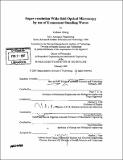Super-resolution wide-field optical microscopy by use of Evanescent standing waves
Author(s)
Chung, Euiheon
DownloadFull printable version (12.10Mb)
Other Contributors
Harvard University--MIT Division of Health Sciences and Technology.
Advisor
Peter T.C. So.
Terms of use
Metadata
Show full item recordAbstract
The development of high resolution, high speed imaging techniques allows the study of dynamical processes in biological systems. Optical fluorescence microscopy is an essential tool for investigations in many disciplines in biology and medicine with molecular specificity. The resolution of optical far-field microscopy has been limited by the wave nature of light. In this thesis, a microscopy technique, standing wave total internal reflection fluorescence (SW-TIRF), has been developed with resolution beyond the classical diffraction limit. The SW-TIRF approach modifies the point-spread function to effectively decrease the excitation wavelength by utilizing an evanescent standing wave, carrying high spatial frequency information near the interface between the specimen and a high refractive index substrate. Evanescent standing wave illumination is used to generate a sinusoidal, high-spatial frequency, fringe pattern on the specimen providing lateral resolution enhancement. Furthermore, the less than 100 nm penetration depth of the evanescent field from the substrate ensures a thin excitation region resulting in low background fluorescence. The first experimental realization of SW-TIRF in an objective-launched geometry demonstrates the potential for super-resolution imaging at high speed in wide-field microscopy. (cont.) The super-resolution has been realized with the effective point-spread function providing better than a fifth of the emission wavelength or approximately 100 nm, which is better than twice that of conventional microscopy. In addition, imaging biological specimens with SW-TIRF demonstrated the performance revealing the fine actin cytoskeleton structures of fibroblasts. On the other hand, the surface plasmons induced by evanescent fields at a specific angle can generate an enhanced electric field which can effectively excite fluorophores near a metal coated surface. We observed a unique doughnut-shaped point-spread function of surface plasmon coupled emission and explained it with theoretical modeling using vector field theory. The combination of surface plasmon resonance fluorescence imaging and SW-TIRF resulted in a novel high-resolution microscopy, the standing wave surface plasmon resonance fluorescence (SW-SPRF) microscopy. These findings may allow super-resolution imaging with even higher sensitivity and signal-to-noise ratio at high imaging speed.
Description
Thesis (Ph. D.)--Harvard-MIT Division of Health Sciences and Technology, 2007. Vita. Includes bibliographical references.
Date issued
2007Department
Harvard University--MIT Division of Health Sciences and TechnologyPublisher
Massachusetts Institute of Technology
Keywords
Harvard University--MIT Division of Health Sciences and Technology.